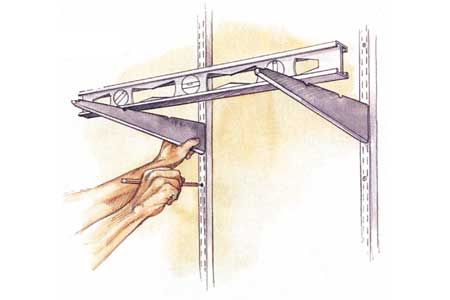Getting your shelving brackets level with each other is trickier than it looks. Luckily, we’ve got some expert tips that can help you perfectly align shelves using wall-mounted shelf standards and brackets. You’ll just need a few basic tools that you likely already have in your garage.
Tools and Materials You’ll Need for Shelf Leveling
Here is a list of tools and materials required for shelf leveling:
Tools
- Drill with appropriate drill bits
- Level (preferably 4-foot)
- Pencil
- Safety glasses
- Screwdriver
- Stud finder
- Tape measure
Materials
- Screws appropriate for your wall type
- Shelf brackets
- Shelves
- Wall anchors (if not screwing into studs)
- Wall-mounted shelf standards
Planning ton Install and Level Shelves
Choose a wall area for your shelves that meets your storage needs and complements your room’s design. Think about the items you’ll store, making sure there is enough space above and below the shelf. Avoid areas with obstacles like light switches, outlets, or vents.
Use a stud finder to locate the wall studs and lightly mark their positions with a pencil. Typically, studs are spaced 16 or 24 inches apart. Attaching your shelf standards to these studs will maximize stability and weight-bearing capacity. However, you can also use wall anchors if you must position a shelf outside studs.
Install the First Shelf Standard
Begin by installing one shelf standard, which will serve as your reference point for aligning the rest of your shelving system.
Position your first standard against the wall, aligning it with the marked stud locations. Use a level to ensure it’s perfectly vertical. Mark the screw holes with a pencil, then pre-drill pilot holes for your screws. Securely fasten the standard to the wall, driving screws deep into the studs for maximum hold.
Double-check the standard’s vertical alignment using your level. Make any necessary adjustments before fully tightening all screws.
Align the Second Shelf Standard
Once the first standard is in place, align the second standard to make sure your shelves are level.
Install a shelf bracket into the first standard. Then, place a second bracket at the same height on the second standard, but wait to attach it to the wall. Lay your level across the two brackets to see if the second standard needs adjustment to achieve perfect alignment.
Hold the second standard against the wall and adjust its position until the level indicates that the brackets are perfectly horizontal. Mark the screw holes for the second standard, then remove the bracket. Pre-drill holes and secure the standard to the wall, following the same process used for the first standard.
Troubleshooting Common Shelf Alignment Issues
Use the steps below to correct any issues during your shelf installation.
Dealing with Uneven Walls
If your walls are not perfectly flat, you may need to use shims behind the standards to achieve a level result. Place thin wooden shims behind the standard to align it with the others.
Adjusting Bracket Positions
If your shelves aren’t level after installation, you can make minor adjustments by slightly repositioning the brackets within the standards. Most bracket systems allow small height adjustments that correct minor leveling issues.
Tips for Maximizing Shelf Space
Once your standards are securely in place and level, you can focus on optimizing your storage space.
Optimal Shelf Spacing
When deciding on shelf spacing, consider the items you’ll be storing. Books typically require about 10-12 inches of clearance, while taller items like vases or storage boxes may need more space. Adjust your bracket positions to accommodate your specific storage needs.
Weight Distribution Considerations
When loading your shelves, be mindful of weight distribution. Place heavier items closer to the standards and distribute weight evenly across the shelf. This will help prevent sagging and ensure your shelving system remains stable.
Maintaining Level Shelves
To keep shelves maintained and aligned, periodically check your shelves for any signs of sagging or loosening. Inspect the standards and brackets to ensure they remain securely fastened to the wall. Additionally, the weight of stored items and natural settling may cause slight shifts in your shelving system. Tighten any loose screws and readjust brackets as necessary to maintain level shelves.
Alternative Shelving Systems
While wall-mounted shelf standards and brackets offer a versatile and sturdy shelving solution, other options are available based on your specific needs and preferences.
Floating shelves provide a sleek, modern look with hidden brackets or supports. They are ideal for displaying decorative items or books without visible hardware. Installation requires precise measurement and secure attachment to wall studs or anchors for stability.
Built-in shelves are custom-made to fit a specific space, offering a seamless and integrated look. They are typically built into alcoves, around fireplaces, or as part of custom cabinetry. Built-in shelves enhance a room’s overall design and offer substantial storage options.
Our Conclusion
Achieving perfectly level shelves requires careful attention to detail and patience. Double-check all measurements and markings before drilling any holes. Use a laser level when installing larger shelving projects or working across long wall spans. This tool projects a perfectly level line across your work area, making aligning multiple standards over greater distances easier.

